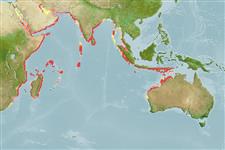Teleostei (teleosts) >
Tetraodontiformes (Puffers and filefishes) >
Tetraodontidae (Puffers) > Canthigasterinae
Etymology: Canthigaster: Greek, kanthos = the outer or inner corner of the eye, where the lids meet, 1646 + Greek, gaster = stomach (Ref. 45335).
Eponymy: Wilhelm Karl Hartwig Peters (1815–1883) was a German zoologist and traveller who made some very important collections in Mozambique. [...] (Ref. 128868), visit book page.
Environment: milieu / climate zone / depth range / distribution range
Ecology
Marine; reef-associated; depth range 1 - 25 m (Ref. 90102). Tropical
Indian Ocean: from Oman and East Africa to the Andama Sea.
Size / Weight / Age
Maturity: Lm ? range ? - ? cm
Max length : 9.0 cm TL male/unsexed; (Ref. 90102)
Short description
Identification keys | Morphology | Morphometrics
Dorsal soft rays (total): 8 - 10; Anal soft rays: 8 - 10. This species is characterized by the following: D 8-10 (often 9), A 8-10; pectoral rays 16-18; body depth at dorsal to anal fin origin 2.2-2.5 in SL; head length 2.3-2.6 in SL; snout length 1.2-1.5 in HL; caudal peduncle depth 1.7-2.2 in HL; slightly rounded caudal fin; body brown with numerous white spots on snout, side of body and caudal fin; bluish-white lines mainly around eye region and on upper back, prominent white-edged black spot below dorsal-fin base and abruptly white belly (Ref. 90102).
May be solitary or in pairs (Ref. 90102).
Life cycle and mating behavior
Maturity | Reproduction | Spawning | Eggs | Fecundity | Larvae
Allen, G.R. and M.V. Erdmann, 2012. Reef fishes of the East Indies. Perth, Australia: Universitiy of Hawai'i Press, Volumes I-III. Tropical Reef Research. (Ref. 90102)
IUCN Red List Status (Ref. 130435: Version 2024-1)
Threat to humans
Harmless
Human uses
Tools
Can't connect to MySQL database fbquizv2. Errorcode: Too many connections
